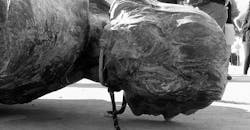One cannot look at statues being vandalized and pulled down, at protests mutating into conquests, without thinking of those who created these works of art. Each artist had a purpose that preceded his effort and an accomplishment that outlasts the moment of his achievement. Realizing Christopher Columbus or U.S. Grant in bronze, the result stands and testifies silently to the artist's feats, together with any intended memorial to explorers, generals, great individuals, and great moments.
Often these were metalcasters anonymously bringing forth the visions of other artists and sculptors. Even today, with design software and computed tomography to execute the process, fine-art foundries will invest months or years to quantify details and express living forms in iron or bronze, in ways that evoke the memory or message of a figure or an event — or make it possible for audiences to apprehend ideas or memories, or feelings conveyed in a more abstract motif.
Statuary is art, of course, but before that it is inspiration, ingenuity, discipline, labor, and skill, in that order. The inspiration feeds the idea, and the sequence proceeds until the work is unveiled. Art arises from humanity in the same way that humanity arises from nature: it's a strain that is identified, then prepared, then perfected.
All metalcasters have an artistic strain. They're craftsmen compelled to undertake a demanding and often punishing vocation. They sacrifice for it. Foundrymen (as once they were commonly called) would tell you that the work selected them, overtook them, but as artists they master the work. It's artisanship that encourages a metalcaster to strive to create better patterns and molds that will form parts that are reliable and beautiful, with durability to perform a task and an appearance that pleases the creator as well as the inspector.
It's the skill evident in the craftsman's work that explains why Bronze Age vessels still hold our fascination, to say no less of ancient Greek statuary. The form that we discover tells us as much or more about the maker and his time as the work does about his subject.
And yet the artist always works for a patron, or a crowd, and today the crowd is a mob calling for something quite different than an artistic expression of a man or a moment, or a memory. In fact it wants none of that. It wants to impose its own verdict on the present, so the competing evidence of history must be discredited, destroyed. Note that the crowd's message is all verdict without judgment. Mobs do not think, they charge. They do not express the insight of individuals but a reaction from nature, seizing power when reason has been exhausted or abandoned.
Of course it's not the first time in history that statues have been toppled. The Romans did it in Carthage and then the Vandals did it in Rome. The Ottomans did it to Constantinople, and Spanish did it in Mexico. The destroyers' victories do not last, but they make their point before history returns in time to overtake them.
The French and Russians vanquished their own histories for a time, which is perhaps closer in spirit to what we see happening now. Desecrating Notre Dame de Paris and imposing a Temple of Reason made a kind of sense in its moment, ironic if not actually reasonable. It lasted barely 10 years. What need has a crowd for reason when it has power and will?
The present-day desecrators draw their explanations from the idle mania that thrives in classrooms and draft chapters and internet chats, confidently and self-pityingly reinterpreting any established knowledge as a hoax or conspiracy. Everything is open to attack, and nothing is safe when no one will defend it. This is art in reverse: the ill-considered ideas are not clarified but grow more unwieldy, discipline fails and short-cuts displace effort. Finally, skill is abandoned and nerve takes its place. The statues are ruined. Soldiers and statesmen, great saints and exceptional citizens all are brought down the same way, sacrificed as much as destroyed.
What has failed is not the craftsman's effort or the designer's vision, nor even the subject's cause. The failure was the patronage that dissipated. That which moved a community to commission a statue of Columbus or Grant, and then rewarded an artist and curated or conserved the work for decades, became interested in other things and then interested only in themselves. The bronze solidified ideals that the patrons no longer grasped.
In the aftermath we may learn the cost of these desecrations. A price may be assigned for replacing a statue, but the value will never be recovered. History will regain its footing once the proper order is restored.
About the Author
Robert Brooks
Content Director
Robert Brooks has been a business-to-business reporter, writer, editor, and columnist for more than 20 years, specializing in the primary metal and basic manufacturing industries. His work has covered a wide range of topics, including process technology, resource development, material selection, product design, workforce development, and industrial market strategies, among others.
